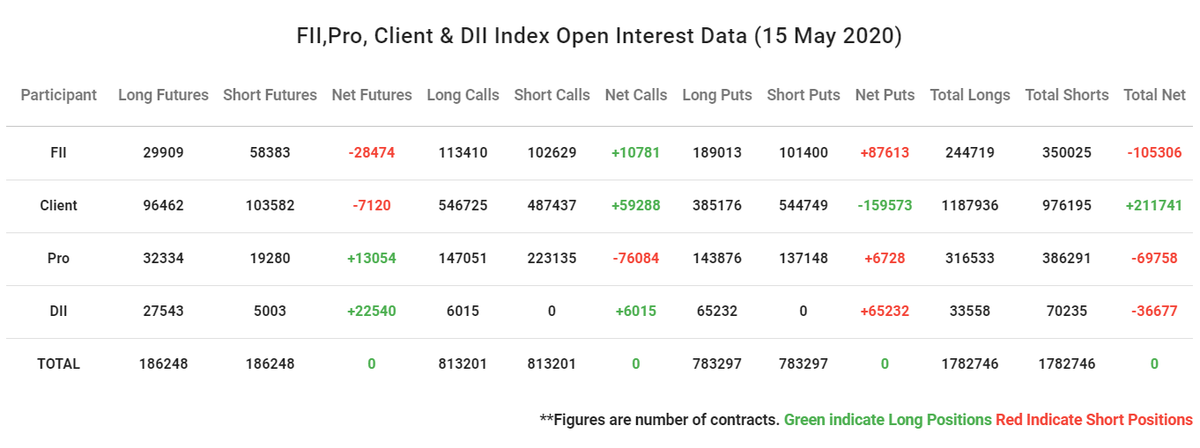
Delta (denoted as ∆) is the Options Greek that tells us the sensitivity of options price in response to the rate of change in the underlying. More specifically, delta tells us about the options expected price change relative to a one-point change in the underlying.
#delta
#delta
For example, a delta of 50% means, for every one-point change in the underlying, the options price changes by 0.5 points and similarly, a delta of 25% means a 0.25-point change in options price for every 1-point move in the underlying.
But Delta (∆) is not constant for any given strike price, it is dynamic and keeps on changing depending on the moneyness of the option strike with respect to the underlying.
Take the example of the 9500CE option from April 3rd, 2020. When the NIFTY futures price was around 8100 the ∆ of 9500CE was around 20 and on April 29 when futures was 9526 the ∆ was around 53 and by Thursday close when futures price was 9860, the 9000CE ∆ is at 69. 

Delta is also a function of money-ness. As the option strike goes in-the-money, the delta keeps on increasing and stays above 50. When it is at-the-money, options have a delta of 50 and when the options go out-of-the-money, the delta of options keep decreasing and stays below 50. 

In-the-money options have a higher change in price relative to the underlying price change due to high delta and in comparison, the out-of-the-money options have a lower change in price due to lower delta.
Let’s consider the example of 3 option strikes which are ITM (9300CE), ATM (9600CE), and OTM (9900CE) on April 29th close when NIFTY futures was 9526.
For a change of 334 points in #NIFTY from 29th to 30th April,
9300CE - 202 pt gain
9600CE - 160 pt gain
9900CE - 120 pt gain
For a change of 334 points in #NIFTY from 29th to 30th April,
9300CE - 202 pt gain
9600CE - 160 pt gain
9900CE - 120 pt gain

Delta is also a measure of an options’ risk relative to the direction of the movement of the underlying. A positive delta indicates bullishness of the options strategy while a negative delta indicates bearishness and a delta closer to zero indicates a non-directional bet.
An underlying futures contract will always have a delta of 100. Buying a futures contract means the delta will be +100∆ while selling a futures contract will make the position -100∆.
If the net positional delta of an options strategy is +50∆, it means the strategy’s worth is equivalent to half of the futures contract value. If a trader owns 10 option contracts with a+50∆, then his net position is +500∆ which is equivalent to holding 5 futures contracts.
Call options have positive delta while put options have negative delta and inversely, the short call option will have a negative delta and short put option have positive delta. 

With this theoretical understanding of delta, a delta neutral trader can do adjustments to his options positions to maintain delta neutrality by neutralizing any +ve or -ve delta that might arise in course of holding the options trade due to movement in the underlying price.
Similarly, a trade can use this knowledge of Delta to construct synthetic futures, synthetic covered calls, and several other synthetic derivative constructs.
I Will add more to this thread later.
I Will add more to this thread later.
Delta can also be roughly used to estimate the probability of an option expiring in-the-money. Though it is mathematically imprecise, it still can be used as a thumb rule by the trader to arrive quickly at probability of an option expiring ITM.
An option with a Delta of 50 (irrespective of + or – sign) has a rough statistical probability of 50% chance of expiring ITM. Similarly, a 30 Delta and 80 Delta options will have 30% and 80% probability of expiring in ITM respectively.
The levels of implied volatility (IV) affect the Deltas of the options. The effect of IV on Deltas is more on far ITM and OTM options than near or ATM options.
An ITM option with a 75∆ at low IV will have relatively lower delta with increased implied volatility while an OTM option with a 25∆ will have relatively higher delta with increased implied volatility. 



Effect of Time on Delta:
The more time left in the life of an option, the more time the underlying has to react and thus more uncertainty that an option will be in-the-money or out-of-the money.
The more time left in the life of an option, the more time the underlying has to react and thus more uncertainty that an option will be in-the-money or out-of-the money.
As a result, the long-dated ITM and OTM options will have deltas drifting closer to 50 reflecting the uncertainty while closer to expiry ITM and OTM options will have deltas drifting close to 100 or zero.
This can be better illustrated by looking at the Deltas of a weekly expiry and monthly expiry ITM Call Options and OTM Put Options. 



• • •
Missing some Tweet in this thread? You can try to
force a refresh







